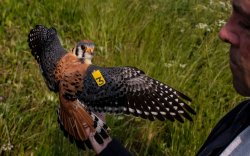The Mystery of the Vanishing Kestrels: What’s Happening to This Flashy Falcon?
The number of American kestrels has dropped sharply. That goes against the trend for birds of prey, broadly seen as a conservation bright spot
Posted in: In the Media, Our Research

John Smallwood, Professor of Biology, spoke with Catrin Einhorn from the New York Times about the American kestrel.
About 30 years ago, Dr. Smallwood, set up 100 nest boxes in what should be some of New Jersey’s prime kestrel habitat, attaching them to utility poles and trees near fields and meadows. The first year, 1995, kestrels made three nests. The next year, there were seven, then 26. By 2002, they reached a high of 61. But then the number of nests started dropping. Last year, there were only 21. This year again, the vast majority of his boxes sit empty of kestrels. On a recent afternoon, some contained only wood chips. One had been claimed by bluebirds.
The kestrel nests that do exist are carefully tracked.
Here’s how to catch a kestrel in a nest box: Approach slowly, ideally masking your sound with a passing car or plane. One person covers the nest hole with a net while another climbs a ladder and unlatches the box from the side. (This is all illegal without federal and state permits.)
“Hello. We’re old friends, we know each other from way back.
Dr. Smallwood and two graduate students record data for each bird: band number, weight, molting status. A plucked feather yields DNA. Studies have shown, he noted, that kestrels tolerate such handling without suffering nest losses.
